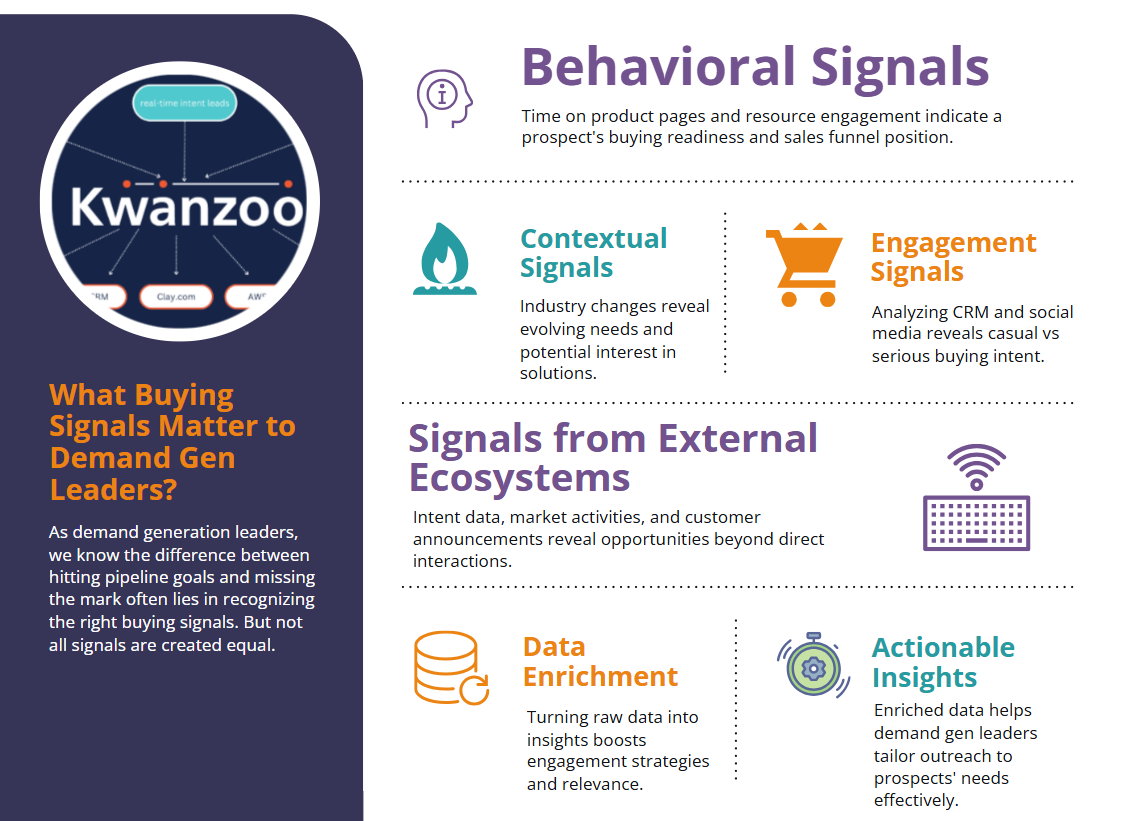
As demand generation leaders, we know the difference between hitting pipeline goals and missing the mark often lies in recognizing the right buying signals. But not all signals are created equal. It’s about identifying the indicators that truly matter, rooted in data that provides actionable insights.
Let’s explore the key categories of buying signals and how they can shape demand generation success.
1. Behavioral Signals: What Prospects Do Tells the Story
Behavioral signals are often the most direct indicators of a prospect’s intent to buy. These are actions prospects take that reveal their interest level and where they are in their journey.
Website Engagement: Time spent on product pages, downloads of case studies or whitepapers, and engagement with pricing pages are clear intent indicators.
Content Interactions: Attendance at webinars, opening and clicking through email campaigns, and responses to surveys highlight prospects’ interest areas.
Trial and Product Usage: For product-led organizations, metrics like feature adoption, login frequency, and usage patterns can pinpoint prospects ready for an upgrade or purchase.
When these signals are tracked in real time and correlated with firmographics (e.g., company size or industry), they enable precise prioritization and outreach.
2. Contextual Signals: What’s Changing in Their World?
While behavioral signals focus on direct interactions, contextual signals provide a broader view of prospects' environment and evolving needs.
Organizational Changes: Job changes, leadership hires, and new strategic initiatives often indicate shifting priorities and potential interest in solutions.
Industry Trends: Monitoring sector-specific growth drivers, such as compliance updates or new regulations, can highlight timely opportunities.
Competitive Movements: Changes in a company’s tech stack, including adopting complementary tools or switching providers, signal readiness for solutions that integrate well or solve gaps.
By layering contextual signals on top of behavioral data, demand generation leaders gain a sharper understanding of when prospects are most likely to engage.
3. Engagement Signals: Beyond the Surface
Deep engagement signals provide the nuance demand gen leaders need to differentiate between curiosity and genuine buying intent.
CRM Interactions: Patterns in deal velocity, closed/lost insights, and repeat engagement help refine scoring models and better predict buying behavior.
Community and Social Interactions: Participation in forums, comments on brand-related posts, or joining a webinar Q&A session shows interest beyond formal channels.
Conversations with Sales: Sentiment and topics discussed in calls or meetings can reveal pain points or urgency that aren’t always visible through data.
Integrating these signals ensures alignment between sales and marketing teams, fostering smoother handoffs and more productive conversations.
4. Signals from External Ecosystems
External signals enrich the picture by offering insights into prospects' environment and behavior beyond direct brand interactions.
Intent Data: Keyword trends, topic interest from third-party platforms, and competitor research indicate prospects’ areas of focus.
Market Activities: Fundraising events, product launches, and expansion into new markets provide insights into a company’s growth trajectory and readiness to invest.
Customer Announcements: Strategic partnerships or public commitments to new initiatives can align with your solution’s value proposition.
These signals can help uncover opportunities your team might not otherwise have surfaced.
5. Data Enrichment: Turning Signals into Actionable Insights
For demand generation efforts to be effective, raw data must be transformed into actionable insights. This is where enrichment comes into play.
Company Insights: Revenue, headcount, and growth indicators provide context about organizational readiness.
Contact-Level Data: Role, seniority, and department data ensure personalized outreach that resonates.
Tech and Competitor Stack: Insights into the tools prospects use or competitors they engage with inform positioning and messaging strategies.
When enriched with these layers, buying signals become a roadmap for engaging prospects in ways that are both timely and relevant.
Bringing It All Together
The most effective demand generation leaders understand that no single signal can tell the whole story. By integrating behavioral, contextual, engagement, external, and enrichment signals into a unified framework, they create a well-rounded picture of buying intent.
It’s not just about collecting data—it’s about connecting the dots. When signals are brought together thoughtfully, they drive more precise prioritization, sharper personalization, and ultimately, stronger pipeline outcomes.
As demand generation evolves in an era of data-driven marketing, focusing on the signals that truly matter will set your team up for sustained success.
New Title
What Buying Signals Matter to Demand Gen Leaders?

As demand generation leaders, we know the difference between hitting pipeline goals and missing the mark often lies in recognizing the right buying signals. But not all signals are created equal. It’s about identifying the indicators that truly matter, rooted in data that provides actionable insights.
Let’s explore the key categories of buying signals and how they can shape demand generation success.
1. Behavioral Signals: What Prospects Do Tells the Story
Behavioral signals are often the most direct indicators of a prospect’s intent to buy. These are actions prospects take that reveal their interest level and where they are in their journey.
Website Engagement: Time spent on product pages, downloads of case studies or whitepapers, and engagement with pricing pages are clear intent indicators.
Content Interactions: Attendance at webinars, opening and clicking through email campaigns, and responses to surveys highlight prospects’ interest areas.
Trial and Product Usage: For product-led organizations, metrics like feature adoption, login frequency, and usage patterns can pinpoint prospects ready for an upgrade or purchase.
When these signals are tracked in real time and correlated with firmographics (e.g., company size or industry), they enable precise prioritization and outreach.
2. Contextual Signals: What’s Changing in Their World?
While behavioral signals focus on direct interactions, contextual signals provide a broader view of prospects' environment and evolving needs.
Organizational Changes: Job changes, leadership hires, and new strategic initiatives often indicate shifting priorities and potential interest in solutions.
Industry Trends: Monitoring sector-specific growth drivers, such as compliance updates or new regulations, can highlight timely opportunities.
Competitive Movements: Changes in a company’s tech stack, including adopting complementary tools or switching providers, signal readiness for solutions that integrate well or solve gaps.
By layering contextual signals on top of behavioral data, demand generation leaders gain a sharper understanding of when prospects are most likely to engage.
3. Engagement Signals: Beyond the Surface
Deep engagement signals provide the nuance demand gen leaders need to differentiate between curiosity and genuine buying intent.
CRM Interactions: Patterns in deal velocity, closed/lost insights, and repeat engagement help refine scoring models and better predict buying behavior.
Community and Social Interactions: Participation in forums, comments on brand-related posts, or joining a webinar Q&A session shows interest beyond formal channels.
Conversations with Sales: Sentiment and topics discussed in calls or meetings can reveal pain points or urgency that aren’t always visible through data.
Integrating these signals ensures alignment between sales and marketing teams, fostering smoother handoffs and more productive conversations.
4. Signals from External Ecosystems
External signals enrich the picture by offering insights into prospects' environment and behavior beyond direct brand interactions.
Intent Data: Keyword trends, topic interest from third-party platforms, and competitor research indicate prospects’ areas of focus.
Market Activities: Fundraising events, product launches, and expansion into new markets provide insights into a company’s growth trajectory and readiness to invest.
Customer Announcements: Strategic partnerships or public commitments to new initiatives can align with your solution’s value proposition.
These signals can help uncover opportunities your team might not otherwise have surfaced.
5. Data Enrichment: Turning Signals into Actionable Insights
For demand generation efforts to be effective, raw data must be transformed into actionable insights. This is where enrichment comes into play.
Company Insights: Revenue, headcount, and growth indicators provide context about organizational readiness.
Contact-Level Data: Role, seniority, and department data ensure personalized outreach that resonates.
Tech and Competitor Stack: Insights into the tools prospects use or competitors they engage with inform positioning and messaging strategies.
When enriched with these layers, buying signals become a roadmap for engaging prospects in ways that are both timely and relevant.
Bringing It All Together
The most effective demand generation leaders understand that no single signal can tell the whole story. By integrating behavioral, contextual, engagement, external, and enrichment signals into a unified framework, they create a well-rounded picture of buying intent.
It’s not just about collecting data—it’s about connecting the dots. When signals are brought together thoughtfully, they drive more precise prioritization, sharper personalization, and ultimately, stronger pipeline outcomes.
As demand generation evolves in an era of data-driven marketing, focusing on the signals that truly matter will set your team up for sustained success.
Pratibha Jain • January 14, 2025


